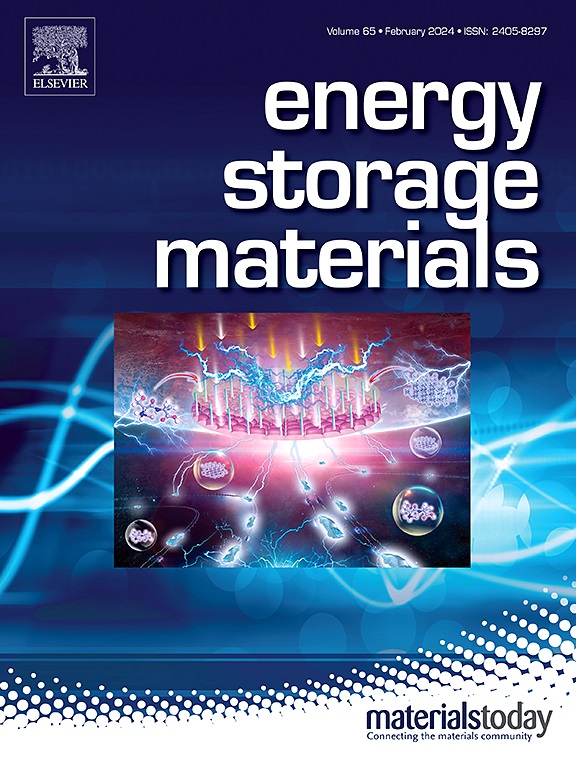Upcycling Mixed Spent Ni-Lean Cathodes into Ni-Rich Polycrystalline Cathodes
IF 18.9
1区 材料科学
Q1 CHEMISTRY, PHYSICAL
引用次数: 0
Abstract
Sustainable battery recycling is vital for conserving resources and reducing environmental impacts. Current open- and closed-loop recycling strategies often focus on recovering individual components, making the reuse of mixed cathode materials a complex challenge. Meanwhile, the research on upcycling has been limited to using pristine cathode feedstocks and virgin materials for synthesis. To address this issue, we present an upcycling approach for spent Ni-lean mixed cathode materials that integrate an upcycling hydrometallurgical recycling process with traditional hydrometallurgical methods. This strategy achieves a utilization of 92.31 mol % of recycled materials, enabling the regeneration of Ni-rich cathode materials while significantly reducing the reliance on virgin resources. The regenerated 83Ni cathode materials demonstrate physical properties comparable to those produced from virgin materials. Electrochemical evaluations using single-layer pouch cells show that both recycled and virgin cathodes exhibit initial specific capacity close to 201.1 mAh/g and maintain approximately 88 % capacity retention after 500 cycles. Additionally, 2Ah cells confirmed these findings, delivering 85 % capacity retention after about 900 cycles. Techno-economic analysis demonstrates notable environmental benefits, including reductions in greenhouse gas emissions and energy consumption, achieving 232.75 MJ/kg of product, which is 8.6 % lower than traditional methods and comparable to direct upcycling. Furthermore, the upcycling hydrometallurgical recycling process generates the highest profit, proving its economic viability. This scalable and versatile process is adaptable to varying transition metal compositions, facilitating a closed-loop recycling system that bridges mixed spent cathodes with next-generation cathode materials, and offers a sustainable solution for managing waste battery materials.
废贫镍混合阴极升级为富镍多晶阴极
可持续的电池回收对于节约资源和减少环境影响至关重要。目前的开环和闭环回收策略往往侧重于回收单个组件,使得混合阴极材料的再利用成为一项复杂的挑战。与此同时,升级回收的研究仅限于使用原始阴极原料和原始材料进行合成。为了解决这一问题,我们提出了一种废镍贫混合阴极材料的升级回收方法,该方法将升级回收过程与传统的湿法冶金方法相结合。该策略实现了92.31 mol%的回收材料利用率,实现了富镍正极材料的再生,同时显著降低了对原生资源的依赖。再生的83Ni正极材料具有与原始材料相当的物理性能。使用单层袋电池的电化学评估表明,回收和原始阴极的初始比容量都接近201.1 mAh/g,并且在500次循环后保持约88%的容量保留率。此外,2Ah电池在900次循环后仍能保持85%的容量。技术经济分析显示了显著的环境效益,包括减少温室气体排放和能源消耗,达到232.75 MJ/kg产品,比传统方法低8.6%,与直接升级回收相当。此外,升级循环湿法冶金回收工艺产生了最高的利润,证明了其经济可行性。这种可扩展和通用的工艺可适应不同的过渡金属成分,促进闭环回收系统,将混合的废阴极与下一代阴极材料连接起来,并为管理废电池材料提供可持续的解决方案。
本文章由计算机程序翻译,如有差异,请以英文原文为准。
求助全文
约1分钟内获得全文
求助全文
来源期刊

Energy Storage Materials
Materials Science-General Materials Science
CiteScore
33.00
自引率
5.90%
发文量
652
审稿时长
27 days
期刊介绍:
Energy Storage Materials is a global interdisciplinary journal dedicated to sharing scientific and technological advancements in materials and devices for advanced energy storage and related energy conversion, such as in metal-O2 batteries. The journal features comprehensive research articles, including full papers and short communications, as well as authoritative feature articles and reviews by leading experts in the field.
Energy Storage Materials covers a wide range of topics, including the synthesis, fabrication, structure, properties, performance, and technological applications of energy storage materials. Additionally, the journal explores strategies, policies, and developments in the field of energy storage materials and devices for sustainable energy.
Published papers are selected based on their scientific and technological significance, their ability to provide valuable new knowledge, and their relevance to the international research community.
 求助内容:
求助内容: 应助结果提醒方式:
应助结果提醒方式:


